
Rare William & Mary English Provincial silver trefid spoon Tiverton c1689
May 27, 2022
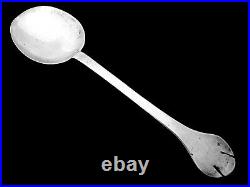
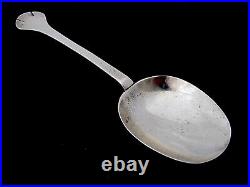
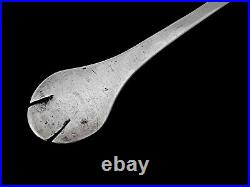
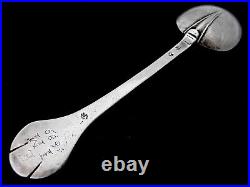

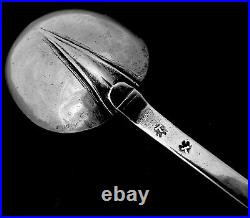


A rare English Provincial West Country silver trefid spoon with a ribbed rat tail, inscribed’E over I. M 1689′, struck three times on the stem with the town mark’T’ for Tiverton. Study stem and pleasing feel, terrific collector’s spoon. This rare spoon is in lovely collector’s condition having a good patina, nice marks, with some age-related wear mainly to the edge of the bowl, which is thin. Late 17th century town mark’T’ for Tiverton c 1689. Britannia silver is an alloy of silver containing 11 ounces and 10 pennyweight silver in the pound troy, equivalent to 95.83% by weight silver, the balance being usually copper. This higher standard of silver content of 958 parts per thousand was introduced in England by Act of Parliament in 1697 to replace sterling silver (92.5% silver) as the obligatory standard for items of “wrought plate”. The lion passant gardant hallmark denoting sterling was replaced with “the figure of a woman commonly called Britannia”, and the leopard’s head mark of the Worshipful Company of Goldsmiths replaced with a “lion’s head erased”. Britannia standard silver was introduced as part of the great recoinage scheme of William III from 1696, when attempts were made to limit the clipping and melting of sterling silver coinage. A higher standard for wrought plate meant that sterling silver coins could not easily be used as a source of raw material because additional fine silver, which was in short supply at the time, would have to be added to bring the purity of the alloy up to the higher standard. Britannia silver is considerably softer than sterling, and after complaints from the trade sterling silver was authorised again for use by silversmiths from 1 June 1720, and thereafter Britannia silver has remained an optional standard for hallmarking in the United Kingdom and Ireland. I have many stunning pieces of collector’s silver in my shop, please look at my other items. I aim only to list antique silver items that are without damage, repair, alteration or undue wear. My silver pieces are ideal as special gifts, for collectors, for investors, or for resale by dealers. I provide clear descriptions and photos. The silver is photographed in flat natural light, but silver is so reflective that black spots from the camera and other reflections are sometimes unavoidable. Please check the dimensions of the object carefully as apparent size can be deceptive. Bank details provided on request. Sizes, weights etc are all approximate. This item is in the category “Antiques\Silver\Solid Silver\Cutlery”. The seller is “carlyonsilver” and is located in this country: GB. This item can be shipped worldwide.
- Antique: Yes
- Featured Refinements: West Country early silver spoon
- Composition: Solid Silver
- Product: Early silver Spoons
- Style: Trefid
- Age: Pre-1800
- Material: Solid Silver
- Brand: Tiverton
- Pattern: Trefid
